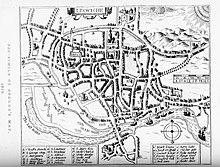


John Speed's Ipswich is a graphic account of the town of Ipswich, Suffolk created by John Speed in conjunction with the Dutch engraver, Jodocus Hondius, in 1610.[1] It was featured as an inset for his map of the county of Suffolk, published in Theatre of The Empire of Great Britaine. It is the earliest extant map of Ipswich and features many buildings of the late medieval period, whilst at the same time showing streets laid out in a grid pattern which has largely been retained into the twenty first century.[2]
John Speed's map contains different key elements:
The river labelled "Orwell flu." has been known as the River Gipping or Little Gipping.
Ipswich was divided into four wards, each further subdivided into parishes centred on a parish church, as follows.[2]
| Ward | |||
|---|---|---|---|
| East | St Clement's (K) | St Mary at the Quay (N) | St Stephen's (H) |
| West | St Matthew's (D) | St Mary-le-Tower (E) | St Mary at the Elms (F) |
| North | St Margaret's (C) | St Helen's (I) | St Lawrence's (G) |
| South | St Peter's (M) | St Nicholas' (L) |
Each ward had a headborough who was the leet officer for the ward.
|
| ||||||||
|---|---|---|---|---|---|---|---|---|
| ||||||||
* Key transposed by Speed | ||||||||